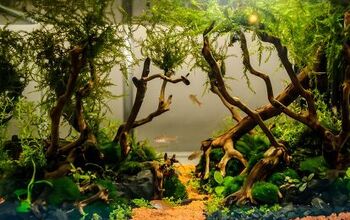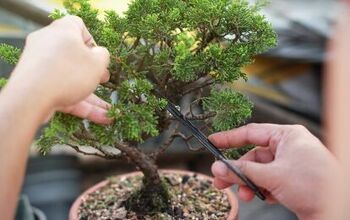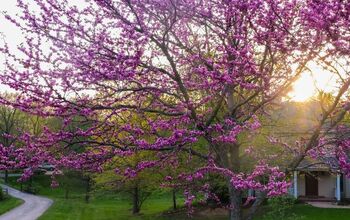How Long Does It Take For A Tree To Grow?

Throughout their lives, trees will continue to grow. They’ll increase in width, add growth rings to their trunks, always put out new branches and sprout leaves. However, when it comes to height, trees grow more slowly with age, so how long does it take a tree to grow?
A tree continues to grow for many years, and depending on the species it will grow anywhere from 20 to 100 years. It can take 10 years for the average tree to reach 18 feet tall. Trees that grow faster can reach 25 feet tall in 10 years under the proper climate and growing conditions. Organic mulch, fertilizer, careful planting, and routine maintenance can make a tree grow quickly.
If you’ve recently moved into a neighborhood or home that has been newly constructed, your yard may seem rather bare. Planting trees can add beauty, shade, interest, and privacy to your property. However, while trees are a natural way to add to the landscape, they are not always the fastest option. Let’s dive in further and examine the factors that influence the rate at which trees grow.
Do You Need Landscaping Services?
Get free, zero-commitment quotes from pro contractors near you.

How Long Does It Take For A Tree To Grow?
This question can often be challenging to answer since “tree growth” can have multiple meanings. In fact, trees grow vertically and in two different directions. While a tree’s roots are spreading deep into the earth and building a strong foundation, we have a much different visual above ground.
We may see a tree grow higher and wider over the years, but we often forget about all the growth that is occurring underground. Every tree has a different growth rate, growth cycle, and lifespan.
Of the over 60 thousand tree species, some grow their roots all year. Yet, their trunks and branches may only grow during certain seasons.
They will reach a point where the growth is so slow-moving that height growth virtually stops. However, they will continue to add rings to their trunks, and grow leaves and branches.
So, if you’re wondering how long it takes for a tree to reach its full size, this depends on a variety of factors. The rate will depend on location, type, soil nutrients, drainage, light exposure, climate, and more.
With that said, it’s hard to determine the exact lifespan of a particular tree. But, we can estimate how long it takes for a tree to grow by understanding what influences tree growth.
What Influences Tree Growth?
Tree size and rate of growth are directly connected to the conditions related to drainage, water, soil, light, fertility, climate, and more. The time that it takes for a particular tree to reach full maturity will depend on many factors. Also, while they play some part, the factors and growth are not directly related to genetics.
In general, the better conditions the tree is given, the faster it will grow. The first thing that you should consider is the soil’s nutrient supply. If the soil your tree is planted in is naturally infertile, you should implement a slow-release fertilizer to enhance growth.
The location where the tree is planted, as well as the climate in the area, are also important factors that influence its growth. An area that has full sun and good drainage will definitely provide good growing conditions for your tree.
Every individual tree has its season where growth is more apparent. In most cases, harsh cold conditions will slow down a tree’s growth rate. For trees to reach their full growth potential, they need the right climate and enough available water.
Additionally, annual maintenance as well as supplemental watering, in the case of droughts, will directly impact the tree’s growth.
How fast a tree grows also depends on the species. There are some with very rapid growth rates and others that grow slower and persist longer. In terms of growth, trees are often designated as fast, medium, or slow-growing.
Slow refers to the fact that the tree grows 12” or less per year; medium indicates 13-24” of growth per year. Fast-growing means that it grows 25” or more.
Average Lifespan Of Different Tree Species
Here’s a glimpse at the average lifespan of various tree species. Typically, trees with a water growth rate won’t last as long as those that grow more slowly.
| Tree Name | Average Lifespan |
| American Elm | 300 years |
| Ash | 120-175 years |
| Beech | 300-400 years |
| Blue Spruce | 150 years |
| Boxelder | 75-100 years |
| Bradford Pear | 20-30 years |
| Cedar Elm | 100+ years |
| Crapemyrtle | 60 years |
| Cypress | 600-1800 years |
| Eastern Hemlock | 450 years |
| Elm (American) | 175-300 years |
| Live Oak | 300 years |
| Magnolia | 80-120 years |
| Maple | 130-300 years |
| Pecan | 300 years |
| Pine (Shortleaf) | 200-300 years |
| Poplar | 100-150 years |
| Redbud | 20-30 years |
| Walnut (Black) | 150-250 years |
| White Oak | 300-600 years |
| Willow | 70-85 years |
A Closer Look At Examples Of Different Growth Rates Of Trees
To give you a better idea of how trees grow, consider some slow-growing trees, like White Cedar and White Oak.
A White Cedar frown about 13 to 24 inches per year in ideal conditions. They can reach up to 40 to 50 feet tall and have a spread of 15 to 20 feet. The trunk can reach a diameter of about 31 inches.
White oaks typically grow about 12 to 14 inches in a year and can take about 30 to 4 years to fully grow.
On the other hand, you also have faster-growing trees. To illustrate how different trees can range from tree to tree, even other species of oaks can grow 48 inches in one year. When you compare this to the slow growth of the White Oak you can see just how individualized a tree’s growth rate is.
For fast-growing trees, a Quaking Aspen is among the fastest, shooting up 36 to 72 inches each year. A weeping willow tree can also grow quickly, adding about 4 to 7 feet of height each year.
Understanding Tree Growth
In order to fully comprehend how long it takes for a tree to grow, you must have a greater understanding of the growth of a tree. The following is a breakdown of tree growth, beginning from a seed and ending in a fully-grown, mature tree.
The Seed Germination Stage (1-3 Weeks)
This is the first step of tree growth, as most often, trees begin growing from seeds. Tree seeds are able to grow in favorable conditions and a moist environment.
Over the course of 1 to 3 weeks, the hard-outer shell of the seed softens, allowing roots to sprout and the tree to start growing. The moist environment is what helps the outer shell soften so that it can break.
The roots sprout, then a couple of leaves and an embryo stem come from the seed, eventually pushing out the ground. At this time, you’ll see a baby tree coming up from the ground.
Seedling And Sapling Stage (6 Months To Several Years)
With the seedling formed, this stage involves the tree growing and developing out of the ground. During this time, the tree needs ideal conditions and maximum protection from various environmental factors that could hinder growth.
These factors include things like light, animals, humidity, water, temperature, and various nutrients. At about three feet tall, the seed becomes a sapling.
A sapling has a flexible stem and smooth bark. It might have some branches. Typically, tree species with longer lifespans will remain saplings for a longer period.
Mature Or Fruit-Bearing Tree (4 Years And On)
Once a tree has grown to be over 10 feet tall, you can consider it full-grown. When trees mature, they grow fruit.
For shorter lifespans, this can take between 2 and 10 years. Whereas, longer lifespans can take over 10 years for fruit production to start.
Ancient Trees (Over 100 Years)
There are some tree species that can take over 100 years to become fully mature. There are undoubtedly many trees across the planet that are some of the oldest organisms on Earth.
The oldest tree in the world is in the Great Basin National Park. It is the Great Basin Bristlecone Pine (Pinus Longaeva) and it is over 5,000 years old.
The tree’s long life is attributed to its harsh environment and slow-growth rate. The combo creates a dense wood that sometimes grows so slowly, the tree won’t even add a growth ring in some years.
Even the needles on this tree can live up to 30 years. This helps the tree conserve energy since it doesn’t need to always produce new ones.
Promoting Rapid Tree Growth
Now that you understand some of the factors that impact a tree’s growth rate, how can you help it grow faster? Let’s examine some steps you can take to ensure your tree has the opportunity to grow taller, faster.
Choosing The Right Tree
To speed the growing process along, choose a tree that is a fast grower and that will thrive in your particular area. In general, trees with a mature height of 50 feet will have a faster growth rate than a tree with a mature height of 15 feet.
Research and examine your tree’s particular soil and sun needs. Each tree will have different requirements for soil acidity, light, water, and climate.
A tree that is situated in an area that does not have the correct soil type will struggle. Likewise, if the area lacks the proper amount of sunlight or temperature, the tree will not be able to thrive and will grow very slowly, if at all.
Plant The Tree Correctly
Planting a new tree properly involves digging a hole that is twice the width and depth of the tree’s root ball. First, place the tree and straighten it. Next, you’ll want to fill the hole with a 50/50 mixture of quality potting soil and soil that came from the hole.
The potting soil you choose should contain all the necessary nutrients for promoting tree growth. Once planted, you’ll begin by watering the tree every day for a week. The following week will shift to watering every other day and then as needed contingent on weather conditions.
Pay close attention to when droughts take place in your area and make sure you’re compensating for the lack of water. If you’re unsure about what or how to plant your tree, consult with an expert. You could end up saving a lot of time and headaches in the long run if you have the work done by a pro.
Profesional planting of a small tree (under three feet) costs about $150 to $300 per tree. If you have multiple trees planted at once, you can likely save a bit per tree. If you have a large tree (over 15 feet) planted, you could pay about $1,500 to roughly $3,000 for the job.
Watering The Roots To Promote Growth
Simply depositing a bunch of water near the base of the tree is not always beneficial as most of it will wash away. Instead, you should water the roots directly or install a drip irrigation system. You could also use a tree watering bag that will water slowly over an extended period of time.
If you choose to directly water the roots, install a root irrigation stake in the ground. Alternatively, you can dig a trench at the base of the tree (not interfering with the roots) and place piping.
At about 2 or 3 feet down, you’ll install a vertical PVC pipe. Then, water directly into the pipe so that it reaches the roots of the tree.
Making Good Use Of Fertilizer
One of the more obvious ways to make a tree grow faster is by using fertilizer. While there are fertilizers specifically formulated for trees, you can use more organic fertilizers.
You can find these at your local home improvement store. However, make sure to use fertilizer mindfully, as it is often misused and misunderstood.
Keep in mind that you shouldn’t use fertilizer to fix plants that are improperly planted, watered, or are unadapted to their environment. Instead of viewing fertilizer as “food”, use it when specific minerals are absent or lacking in the soil composition.
If you notice a problem with your tree, determine the cause and correct it before considering fertilizer.
Implement Organic Mulch
To prevent grass and weeds from competing with your tree for water and nutrients, install a layer of organic mulch around the planted tree. Spread the mulch about 3 to 4 inches out from around the tree. Leave a slight gap between the trunk and the mulch so that it’s not sitting right beside the tree.
Over time, the mulch will slowly begin to biodegrade and deteriorate. Replenish it with fresh mulch as needed.
Perform Regular Maintenance
The existence of mulch can help keep weeds and grass away. However, you should keep up with other regular maintenance of your tree to promote growth. In order to avoid probable stunting effects of removing too many leaves, too early, only prune young shade trees once every two years.
When pruning, also remove any damaged, diseased or dead limbs. You should also cut off any branches that crowd each other or are growing in the opposite direction, toward the tree’s trunk.
Adhere to your specific tree’s pruning requirements as they will vary from tree to tree. Some trees may need more frequent maintenance. For example, fruit trees typically require more vigorous pruning and benefit from it being done often while young.
What Are Signs Of A Dying Tree?
If you think your tree is dying, keep an eye out for these signs:
- If your tree drops a lot of branches and twigs, it might be unhealthy. A healthy tree has flexible stems and branches that won’t easily break off and fall to the ground. Therefore, brittle branches that easily snap are signs that the tree itself is also dead or dying.
- Likewise, if the bark is peeling away easily, there could be underlying issues with the tree. However, it might simply have an illness that needs fixing. This is why calling a professional is important before you assume your tree is dying.
- If the bark is peeled away in a spot and you see no green underneath it, this indicates your tree lacks nutrients. Without proper nutrient flow, your tree might be dying.
- Seeing fungus or other signs of rot on your tree necessitates fast action. When you don’t act quickly to get rid of the rot, it could end up taking over and killing the tree.
More Signs Your Tree Is Dying Or Unhealthy
- If your tree is leaning suddenly, this is a sign that the roots are weakening or damaged. If your tree has been leaning since it was young, it might simply be growing at an angle. But, if it was once straight and is now leaning, this is a sign that it is likely dying and needs removal ASAP.
- Root damage can lead to a dying tree if it is severe. Sometimes, people remove tree roots because they are in the way of construction or other projects. If you notice signs of root damage following nearby construction, call a pro.
- A professional tree trimmer knows how to cut a tree to keep it healthy and safe. But ripping off large branches, or storm damage and other issues can cause large splits and gaps. These are difficult for a tree to recover from. If your tree loses large branches or experiences damage, it can be difficult to prevent it from dying.
- If your tree’s branches are bare when they should normally have leaves, this could signal a problem. It could be due to root damage, or there could be pests or diseases in the tree. Either way, something is hindering nutrients from moving through the tree properly.
Do You Need Landscaping Services?
Get free, zero-commitment quotes from pro contractors near you.

Wrapping It Up
Planting a tree is a wonderful investment that will grow in value (and height) as each year goes by. They can be an excellent way to enhance the natural beauty of your property. Plus, they offer comfortable shading or provide privacy from your neighbors.
In general, the overall size and rate that trees grow will depend on many factors. If you’re looking to quickly enjoy the benefits that come with a newly planted tree, consider planting one labeled as “fast-growing.” These include, but are not limited to the eastern white pine, hybrid poplar, dawn redwood, silver maple, river birch, weeping willow, and areca palm.
However, regardless of the type of tree you choose, make sure that you are planting it correctly. Always follow a dedicated watering schedule, fertilize when needed, implement mulch, and perform regular maintenance.
With proper planning, extra care, and a whole lot of love, your new tree will have the opportunity to reach new heights, in no time.
Related Questions
Can a tree die from old age?
Yes, but many trees often succumb to poor environmental conditions, lack of nutrients, or other factors long before dying of old age. Trees’ metabolic process makes changes over long periods, hundreds of years, so you can’t typically see signs of aging.
Who do you call if you have a sick or dying tree?
If you suspect you have a tree that is dying, it’s important to call a professional arborist to assess the situation. A dying tree can lead to major problems if left unchecked, like falling on your property or a person.An arborist can inspect the tree to determine if it needs removal or if the tree can be saved. If removal is necessary, they can direct you to the appropriate tree removal company to get the job done safely and professionally.
What do I do if I see pests in my tree?
Trees can die if subjected to certain pests like termites and ants. If you notice them early on and take action quickly, you might be able to prevent any problems. However, if the insects have compromised your tree’s stability, you’ll need to take it down to avoid a falling tree.

Jessica considers herself a home improvement and design enthusiast. She grew up surrounded by constant home improvement projects and owes most of what she knows to helping her dad renovate her childhood home. Being a Los Angeles resident, Jessica spends a lot of her time looking for her next DIY project and sharing her love for home design.
More by Jessica Stone



























